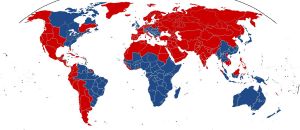Roads in Ill Bethisad
Driving Direction
Right-hand traffic and left-hand traffic mean regulations requiring all traffic to keep either to the left or the right hand side of the road, from their point of view. This is so fundamental to traffic flow that it is sometimes referred to as the rule of the road. Though originally most traffic drove on the left worldwide, today about 55% of the world's people live in right-hand traffic countries and 45% in left-hand traffic countries.
This poses a particular problem with countries sharing land borders, as "overunders", "swizzles", or "pretzels" have been devised to allow the switch to LHT or RHT from the opposite in the nation one is leaving. This is also a problem for island nations which have a great number of foreign visitors who often forget that they are driving in the opposite side of the road.
Some nations have gone to the extent of near constant signage or cement dividers on the main thoroughfares to reduce the number of traffic accidents.
The handedness of driving seems to depend on the colonizing nation, primarily. In places such as sub-Saharan Africa, countries that were RHT have almost entirely switched to LHT, due to the heavy proximity of Dalmatian and British colonized countries. Of all the continents in the world, only Australasia has a unified driving direction. All others have some split.
There have been numerous referendums amidst the Holy Roman Empire to derive a unified driving direction, however, no consensus has been reached to the present time.
Road Systems
Road systems vary from nation to nation, and often, within the nations themselves. Here is what's known about Ill Bethisad.
North American League
In the NAL, there are three hierarchies of highways, each governed and maintained by a different level of governmental oversight.
Post Roads (PR), the federal level highway system, correspond to the various systems of national highways in other countries, like the Interstates and US Routes of *here's* USA or the Autobahn of the HRE. These kinds of roads are built and maintained by a combination of national and provincial funds. Route numbers carry over from province to province. Many Post Roads are a combination of limited access freeways and highways with at grade intersections, especially older roads in built up areas. Newer roads, however, tend to be limited access in character, especially between cities and often bypass built up areas in order to avoid downtown traffic. The more elegant solutions to the problems of realigning old Post Roads involve either the through lane / local lane solution or else a raised section of through lanes. The former solution involves a very broad right of way where four to six lanes of limited access freeway are entrenched into the ground and bounden on either side by local lanes that intersect with city streets, coach lanes and tramways at grade and are regulated by the usual traffic lights; interchange between the local lanes and through lanes is had by a system of slipways and cross streets are made to pass over the through lanes upon bridges. A variation on this theme is the raised freeway, which simply put is a limited access freeway built upon a steel and concrete bridge immediately above the older road which maintains its at grade intersections. An elegant example of the former is PR-40 through Baltimore, with its gracefully arching bridges and beautiful stonework retaining walls. The latter is well exemplified by PR-240 into the Pentapolis. PR-1 through Pentapolis is of the entrenched form and has been mostly built over, mush like the rail trackage into Constantine Station, so that drivers feel like they're going through a long tunnel. Only occasional gaps in buildings or space around bridges reminds one that the tunnel is an illusion.
Provincial Highways (PH) are governed and maintained by province level roads bureaus. These are built and maintained by provincial funds and while the roads may connect to another Provincial Highway at the border, the number designation might change. These are almost never limited access freeways, though some are; and many, especially in rural areas, are little more than narrow single lane carriageways. Several provinces, Virginia especially, are infamous for their paucity of road signage; while others, such as Pennsylvaania are more well known for their near constant regimes of vast areas of road repair projects. One commentator wrote in 2000 that, while taking a bus along PR-30, an overnight trip from New Amsterdam to Pittsburgh was extended into a two and half day long crawl through dozens of ten to thirty mile long roadwork zones.
Carriage Routes (CR) are the lowest in the hierarchy and are maintained by county or parish or other local governments. Some carriage routes are numbered (or lettered) while other municipalities do not assign any codes to their roads. A few assign some internal systematised code, but do not express these codes on road signs. Built with provincial funds, they are maintained by local government agencies.
See: Roads of the NAL for a fairly comprehensive article on the NAL's road system.
[PB]
Monastic Republic
The Trans-Continental Highway
The Trans-Continental Highway connects a number of countries in North America.
Russian Imperial Highways
Central Asian Road Systems
Other Highway Systems
Please describe...

